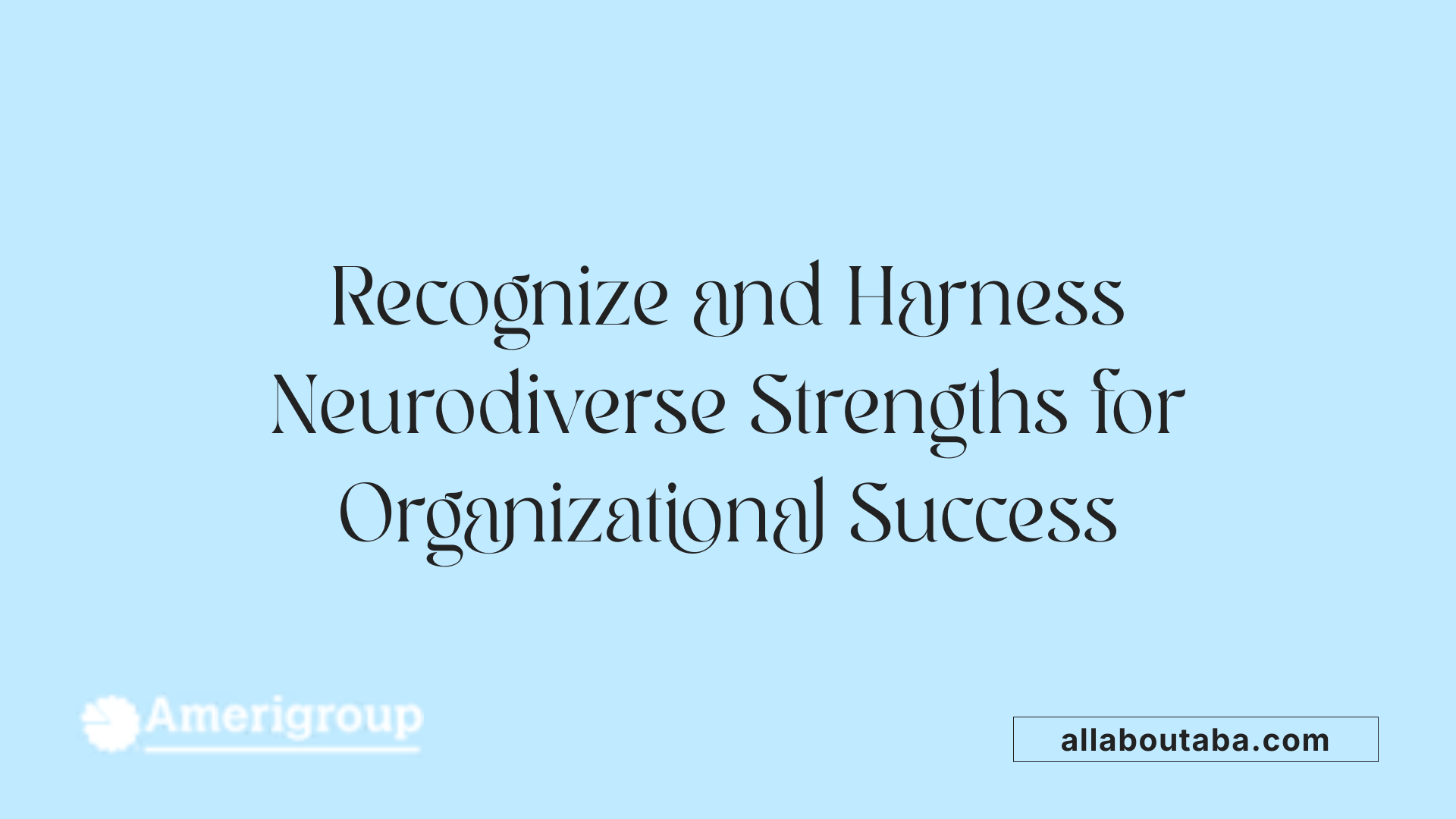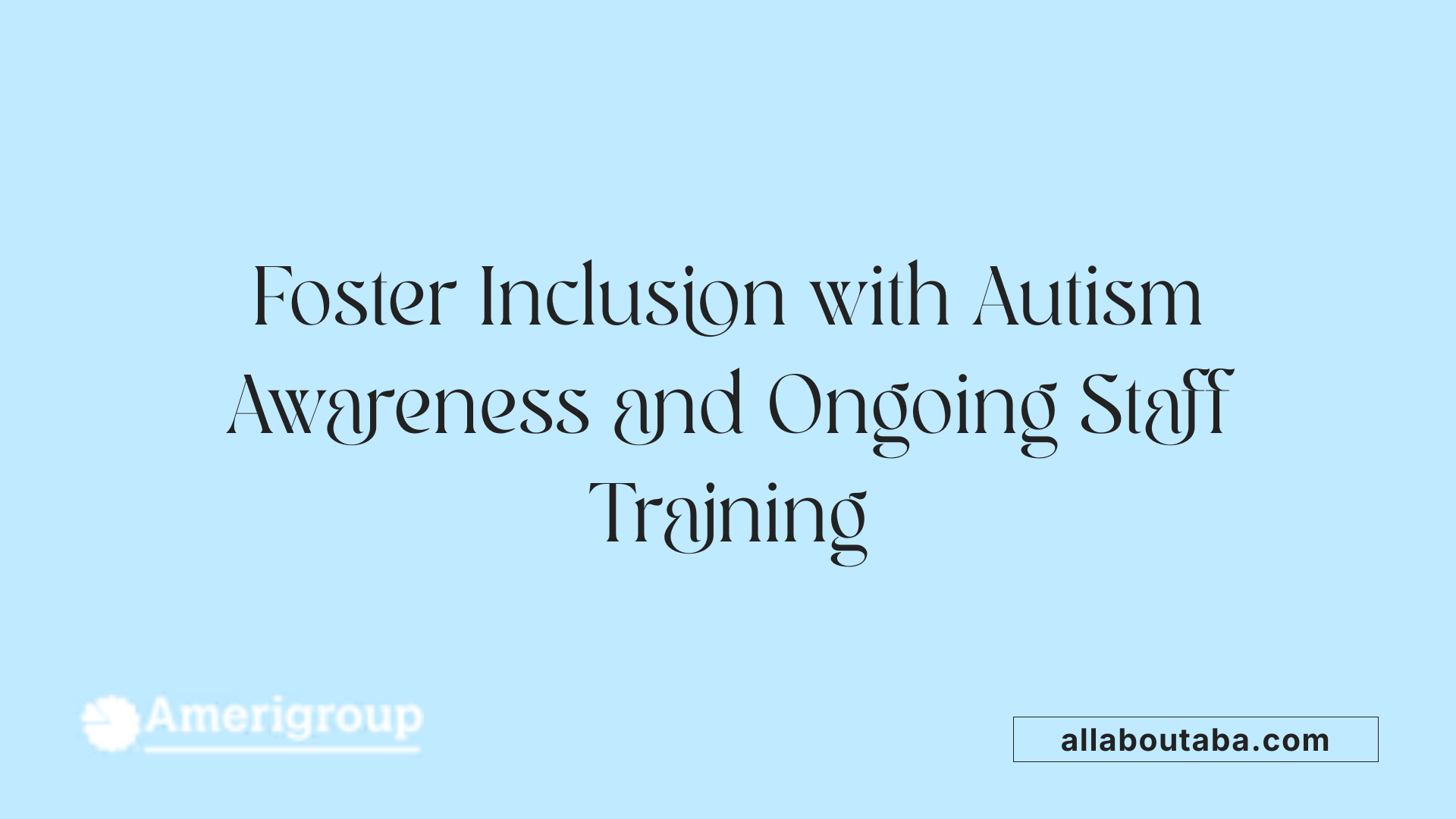Best Ways To Support Autistic Employees In Customer Service Roles
Enhancing Support and Understanding for Autistic Employees in Customer Service
Autistic employees bring valuable skills such as attention to detail, honesty, and creative problem-solving to customer service roles. However, to maximize their potential and ensure a positive work environment, employers need to implement targeted support strategies that address individual needs. This article explores effective accommodations, inclusive practices, and legal considerations to foster a supportive workplace culture for neurodiverse staff, especially in customer-facing roles.
Understanding the Strengths and Challenges of Autistic Employees

What are the strengths of autistic employees?
Autistic employees often bring unique skills and perspectives to the workplace. They excel in areas such as attention to detail, which enables precise work; excellent memory, supporting complex tasks; intense focus, leading to productivity; creativity, fostering innovative solutions; and honesty, promoting trustworthiness. These strengths are particularly valuable in customer service roles, where accuracy, integrity, and problem-solving are essential.
What challenges might autistic employees face in customer service roles?
Despite their strengths, autistic employees may encounter specific challenges. These can include difficulty understanding unwritten social rules, which affects interactions with customers and colleagues. Sensory sensitivities, especially in noisy environments, may cause discomfort or overstimulation. Engaging in small talk or casual social conversations can be stressful, and managing sudden changes or unpredictability may lead to anxiety. Additionally, literal thinking sometimes hampers understanding figurative language or implied messages, impacting communication.
| Strengths | Impact | Challenges | Impact |
|---|---|---|---|
| Attention to detail | Ensures accuracy | Social navigation | Difficulties with unspoken rules |
| Excellent memory | Supports complex tasks | Sensory sensitivities | Discomfort in noisy or bright settings |
| Focus | Boosts productivity | Small talk | Stressful social interactions |
| Creativity | Fosters innovation | Managing change | Anxiety caused by unpredictability |
| Honesty | Builds trust | Literal thinking | Misunderstanding figurative language |
By understanding these attributes, employers can create supportive environments that harness autistic strengths while addressing potential challenges. Tailored accommodations and awareness can lead to rewarding and productive roles for autistic employees in customer service and beyond.
Implementing Practical Accommodations and Workplace Adjustments
Supporting autistic employees in the workplace requires thoughtful and individualized adjustments that promote comfort, productivity, and inclusion. These accommodations are essential to creating an environment where neurodiverse talent can thrive.
One of the most important aspects is providing reasonable adjustments. These are modifications tailored to the needs of each employee that help prevent disadvantages at work. In customer service roles, such accommodations often include clear and detailed communication, visual supports to aid understanding, flexible scheduling, and sensory-friendly environments. For example, offering quiet workspaces or noise-cancelling headphones can significantly reduce sensory overload. Giving advance notice of changes in routines or procedures also helps autistic employees prepare and adapt.
Physical environment adaptations are equally crucial. Workplaces can be adapted to reduce sensory stimuli that might cause discomfort. Creating designated quiet areas, dimming overly bright lights, and limiting strong odors can help mitigate sensory sensitivities. Installing visual cues, such as visual signage or partitions, can also support focus and navigation within the workspace.
Legal frameworks in the UK, including the Disability Act and the Equality Act, reinforce the employer’s obligation to make reasonable adjustments. These legal protections ensure that modifications like environmental changes, flexible working hours, remote options, and assistive technologies are considered part of supporting neurodiverse employees. The Access to Work program further offers financial assistance for such adjustments, covering costs related to sensory equipment, support workers, and travel support.
Implementing these accommodations not only benefits autistic staff but also fosters an inclusive workplace culture where diversity is valued. By individualizing support through open discussions and understanding each employee's unique needs, organizations can unlock the potential of autistic talent, ultimately contributing to better team dynamics and overall success.
Creating an Inclusive Culture Through Training and Awareness

How can organizations foster an inclusive environment for neurodivergent employees?
Fostering an inclusive workplace starts with comprehensive autism awareness training for all staff members. Such training helps employees understand diverse communication styles and thinking patterns, fostering an atmosphere of acceptance and respect. Promoting understanding of neurodiversity leads to a more supportive environment where autistic employees feel valued and included.
What role does staff training play in supporting autistic employees?
Training plays a crucial role by dispelling myths and reducing stigma associated with autism. It equips managers and colleagues with practical strategies to support their autistic coworkers effectively. This includes understanding different sensory needs, communication preferences, and the importance of flexible arrangements, which can significantly improve job satisfaction and retention.
How can organizations normalize workplace adjustments?
Normalizing accommodations involves embedding them into standard workplace policies and encouraging open conversations around support needs. Leadership support is vital, as it demonstrates that adjustments are part of the organizational culture rather than exceptions. Creating a safe space for dialogue helps reduce stigma and encourages employees to disclose their needs without fear of discrimination.
Additional Resources and Recommendations
For organizations interested in expanding understanding, targeted autism awareness training for teams such as customer service can be particularly beneficial. Such training tailored for frontline staff helps create a more empathetic service environment, improving customer interactions while supporting neurodiverse staff.
By investing in training and promoting openness, organizations can cultivate a culture where neurodiversity is recognized as an asset and workplace adjustments are viewed as integral to inclusive practices. This approach not only benefits autistic employees but also enhances overall organizational resilience and innovation.
| Aspect | Action | Benefit |
|---|---|---|
| Autism Awareness Training | Conduct regular sessions for staff | Increases understanding and empathy |
| Policy Integration | Formalize accommodations in policies | Normalizes adjustments |
| Leadership Support | Demonstrate commitment from top management | Reduces stigma and encourages disclosure |
| Specialized Training | Focus on customer service teams | Enhances support and service quality |
Creating a respectful environment where adjustments are normalized and understanding is prioritized enables all employees to thrive, fostering a truly inclusive workplace.
Effective Communication Strategies for Managers and Colleagues
What are best practices for communicating with autistic employees?
Effective communication with autistic employees involves using clear, straightforward language and avoiding idioms or metaphors that can cause confusion. Visual supports like charts, schedules, or written instructions help clarify expectations and tasks. Patience is crucial; giving employees adequate time to process information and respond fosters a respectful environment. Observing non-verbal cues can also provide insight into understanding and comfort levels, especially when verbal communication is challenging.
How can managers support autistic employees who are struggling?
Managers play a vital role in supporting autistic employees facing difficulties. Engaging in open and respectful dialogue allows for understanding individual challenges and needs. Offering flexible work arrangements, such as adjustable hours or remote work options, can reduce stress. Providing a quiet space or calm environment where employees can recharge is beneficial. Additionally, tailoring support through personalized strategies and regular check-ins helps employees manage workplace stress and thrive.
What tips exist for building trust with autistic colleagues?
Building trust requires consistency and reliability in interactions. Demonstrating empathy and understanding fosters a supportive environment. Clearly communicating expectations and respecting individual communication preferences—whether written or verbal—strengthen relationships. Recognizing and valuing diverse strengths and contributions encourages a sense of belonging, which is essential for effective teamwork.
Additional Insights
Research indicates that fostering supportive, understanding work cultures benefits everyone. Providing autism awareness training for teams reduces stigma and promotes respectful interactions. In customer service roles, clear communication and patience are even more critical, highlighting the importance of tailored support for neurodiverse staff.
| Strategy | Implementation Tips | Benefit |
|---|---|---|
| Clear Communication | Use simple language, visual aids | Reduces misunderstandings |
| Flexible Scheduling | Offer remote work, adjustable hours | Decreases workload stress |
| Quiet Spaces | Designate calm zones | Prevents sensory overload |
| Personalized Support | Regular check-ins, specific accommodations | Enhances wellbeing and productivity |
| Awareness Training | Workshops for staff | Builds inclusive culture |
Supporting Well-being and Mental Health in the Workplace

How can workplaces support the mental health of autistic employees?
Supporting the mental health of autistic staff involves creating an environment that reduces stress and accommodates sensory needs. This can include providing a calm workspace with adjustable lighting, noise-cancelling headphones, and sensory-friendly areas. Regular breaks and predictable routines help employees manage anxiety and sensory overload.
Open communication is essential. Employers should encourage staff to discuss their needs and provide access to mental health resources and support programs. Tailoring support based on individual preferences fosters trust and helps autistic employees thrive.
What measures can be taken during stressful situations or workplace conflicts?
Preparing for potential stressors is vital. Notify employees in advance about any disruptive activities, such as office renovations or emergency drills, to give them time to adjust.
Offering quiet spaces where employees can retreat during stressful moments also helps. Creating a supportive atmosphere where employees feel safe to express their feelings minimizes overwhelm and enhances overall well-being.
How does fostering a diverse and inclusive culture benefit everyone?
An inclusive workplace that values neurodiversity promotes resilience and encourages innovative thinking. Recognizing and respecting different cognitive and communication styles allows all employees to contribute their unique perspectives.
This environment nurtures understanding, reduces stigma, and improves team cohesion. Ultimately, supporting neurodiverse individuals not only benefits their mental health but also enhances workplace performance and creates a healthier, more creative organization.
| Aspect | Description | Benefit |
|---|---|---|
| Calm spaces | Designated quiet areas to decompress | Reduces sensory overload |
| Communication | Clear, visual, and written instructions | Minimizes misunderstandings |
| Flexibility | Adjusted work hours and remote options | Prevents burnout |
| Awareness training | Regular autism and mental health seminars | Promotes understanding and empathy |
| Support access | Facilitating mental health resources | Maintains emotional well-being |
Practical Strategies for Promoting Engagement and Participation

What strategies help autistic employees participate fully in team activities?
Supporting full participation of autistic team members requires thoughtful planning and respect for individual preferences. Employers can offer detailed information about upcoming activities beforehand, ensuring clarity and reducing uncertainty. Providing alternative options for participation allows autonomy and comfort, catering to varied sensory and social needs.
Structured social activities with clear goals can help autistic employees understand expectations and engage confidently. Creating an environment where they feel safe to express their boundaries promotes inclusiveness.
How can organizations support autistic employees' personal development?
Supporting growth involves setting personalized goals that align with each individual's strengths and interests. Mentorship programs serve as valuable tools, offering guidance, feedback, and encouragement tailored to the person's developmental needs. Additionally, providing access to skill-building opportunities—such as training sessions or projects matching their passions—can enhance job satisfaction and foster motivation.
What is the role of peer support in fostering inclusion?
Peer support plays a crucial role in creating an inclusive workplace. Mentorship and buddy schemes help autistic employees feel connected and valued. These programs facilitate social integration, boost confidence, and enable sharing of experiences. Peer awareness initiatives educate colleagues about neurodiversity, fostering understanding, reducing stigma, and encouraging supportive interactions.
| Strategy | Description | Benefits |
|---|---|---|
| Detailed Information | Offer comprehensive details on events | Reduce anxiety, increase preparedness |
| Alternative Participation | Provide multiple ways to engage | Respect individual preferences |
| Structured Activities | Use clear goals and routines | Promote confidence and participation |
| Personalized Goals | Tailor objectives based on strengths | Enhance motivation and growth |
| Mentorship/Buddy Schemes | Connect employees for guidance | Foster relationships and support |
| Peer Awareness Initiatives | Educate staff on neurodiversity | Build understanding and acceptance |
Monitoring, Reviewing, and Evolving Support Measures
 To ensure that support strategies for autistic employees remain effective, organizations should establish ongoing assessment and review processes. Regular feedback sessions with staff provide direct insights into what accommodations are working well and where improvements are needed. Anonymous surveys can help gather honest input, especially about sensitive areas that might otherwise go unspoken.
To ensure that support strategies for autistic employees remain effective, organizations should establish ongoing assessment and review processes. Regular feedback sessions with staff provide direct insights into what accommodations are working well and where improvements are needed. Anonymous surveys can help gather honest input, especially about sensitive areas that might otherwise go unspoken.
Reviewing workplace adjustments is also crucial. This includes evaluating the physical environment—such as noise levels, lighting, and visual cues—and the flexibility of work arrangements like hours and remote work options. Collectively, these reviews help identify successful practices and reveal gaps or barriers that still need addressing.
To improve support continuously, organizations should update training programs regularly. Keeping staff informed about new best practices and employee needs fosters an inclusive culture. Adjustments should be flexible, with changes made based on employee feedback and evolving understanding of neurodiverse needs.
Promoting a culture of ongoing learning and adaptation is vital because needs and societal standards change over time. Staying responsive helps organizations remain inclusive and supportive, encouraging neurodiverse staff to thrive. This proactive approach not only benefits employees but also enhances organizational resilience and innovation, especially in roles such as customer service where understanding diverse perspectives enriches service quality.
Building a Truly Inclusive Customer Service Environment
Supporting autistic employees in customer service roles requires a comprehensive, empathetic approach that combines practical accommodations, inclusive culture, effective communication, and ongoing review. By implementing tailored support strategies, fostering awareness, and embracing neurodiversity, organizations can unlock the full potential of their staff, improve service quality, and promote a workplace where everyone feels valued and understood. An inclusive environment not only benefits autistic employees but also enhances team cohesion, innovation, and overall organizational resilience.
References
- An Employer's Guide to Supporting Workers with Autism
- What support can I get at work as an autistic person?
- How can I support an autistic colleague or employee? - Living Autism
- 10 things employers can do to support Autistic staff - Amaze
- Creating Inclusive Work Environments: Autism in The Workplace
- Establishing Workplace Adjustments: How I Learned to Advocate for ...
- Training Autistic Employees - Hire Autism
- Autism at Work: Overcoming Challenges - HelpGuide.org
- Workplace Adjustments for Autistic Employees: What is 'Reasonable'?
Other articles
Recent articles

Best Ways To Foster Collaboration Between Parents And Schools For Autism Support

Supporting Autistic Children During Transitions Between Activities

The Role Of Teachers In Fostering Autism Peer Acceptance

Using Art Therapy To Support Children With Autism

Autism And Strategies For Addressing Sensory Defensiveness

Autism And The Benefits Of Structured Leisure Activities

How To Support Autistic Students During Exam Season

Autism And Goal Setting For Personal Growth

How To Use Gamification In Autism Learning Programs

How Schools Can Reduce Bullying Of Autistic Students

Early Intervention Strategies For Autism Spectrum Disorder

The Role Of Therapists In Autism Life Skills Coaching

How To Support Autistic Individuals In Crisis Situations

Autism And Self-Care Routines For Stress Management

Understanding Echolalia And Its Role In Autism Communication

Autism And Fine Arts Education Benefits

The Impact Of Multisensory Learning On Autism Education

How Family Counseling Supports Autism Household Dynamics

Best Practices For Inclusive Playgrounds For Autism

Best Practices For Autism-Friendly Shopping Centers

How Autism Affects Fine Motor Skill Development

Best Ways To Introduce Sensory Activities Into Daily Routines

How Sports Teams Can Be Inclusive Of Autistic Players

Autism And Strategies For Building Workplace Resilience

Autism And The Impact Of Hormonal Changes During Puberty

How To Support Autistic Students In Foreign Language Classes

Best Ways To Teach Money Skills To Teens With Autism

Supporting Siblings Of Children With Autism

Autism And Co-Occurring Gastrointestinal Disorders

The Role Of Art Projects In Autism Sensory Integration

How Schools Can Incorporate Sensory Break Spaces

Best Practices For Autism Sensory Regulation At School

Autism And Strategies For Teaching Organizational Skills

Understanding The Relationship Between Autism And Anxiety Disorders

Autism And Life Planning For Long-Term Care

Exploring Visual Supports In Autism Education

Ways To Encourage Social Interaction In Children With Autism

The Connection Between Autism And Dyscalculia

The Role Of Occupational Therapy In Transition Planning For Autism

The Role Of Physical Therapists In Autism Motor Skills Support

How To Teach Decision-Making Skills To Autistic Young Adults

The Connection Between Autism And Epilepsy

Best Practices For Transitioning Autistic Children Into New Schools

Autism And Time Management Challenges In Adulthood

The Role Of Visual Arts In Autism Communication Development

How To Address Tactile Defensiveness In Autism

Best Practices For Telehealth Autism Therapy

How To Help Autistic Children Develop Friendship Skills

How Schools Can Support Autistic Students In Career Prep

Best Strategies For Autism-Friendly Event Planning

Understanding Noncontingent Reinforcement In Autism Behavior Plans

How Drama Therapy Benefits Autistic Individuals

Best Practices For Autism-Friendly Fitness And Recreation Centers

Best Ways To Promote Healthy Social Media Use For Autistic Teens

How To Help Autistic Children Cope With Public Speaking

Autism And Strategies For Managing Unexpected Changes

Best Podcasts About Autism For Parents And Educators

Autism And The Impact Of Seasonal Changes On Behavior

The Role Of Diet In Managing Co-Occurring Conditions With Autism

Sleep Challenges In Autism And Practical Solutions

Best Ways To Build Daily Routines For Autistic Children

Best Practices For Supporting Autistic Entrepreneurs

Autism And Strategies For Navigating Large Social Gatherings

Adaptive Sports And Recreational Activities For People With Autism

Autism And The Benefits Of Story-Based Learning Activities

Understanding The Role Of Play In Autism Development

Autism And The Impact Of Environmental Noise On Learning

How To Create Autism-Friendly Community Spaces

Autism And Chronic Health Conditions: What To Know

The Role Of Care Managers In Autism Life Planning

How To Teach Social Boundaries To Autistic Children

How Autistic Individuals Experience Empathy Differently

How To Support Autistic Employees In Remote Work Settings

Autism And The Relationship Between Motor Skills And Learning

How To Create Community Resource Guides For Autism Families

How To Teach Daily Living Skills To Autistic Teens

Autism And The Impact Of Mind-Body Practices On Stress Reduction

Autism And The Benefits Of Outdoor Group Activities

How To Create Autism-Friendly Sensory Paths In Schools

Best Practices For Autism-Friendly Park And Recreation Areas

Autism And Strategies For Reducing School Refusal

Supporting Autistic Individuals In Public Speaking

The Role Of Diet In Managing Autism Symptoms

The Benefits Of Gardening Clubs For Autism Social Development

How To Prepare Autistic Children For Dental Visits

Autism And Employment: Career Paths That Work

Best Practices For Autism-Friendly Hotels And Lodging

The Impact Of Screen Time On Autism Development

Autism Screening Tools For Early Childhood

The Role Of Physical Exercise In Autism Therapy

Best Strategies For Supporting Autistic College Students

The Role Of Technology In Autism Early Detection

Sensory-Friendly Classroom Design Ideas For Autistic Students

The Role Of Speech Therapy In Building Social Communication Skills

Best Strategies For Handling Autistic Burnout In Adults

Autism And The Importance Of Predictability In Routine

Autism And Peer Education: Teaching Acceptance In Schools

Best Practices For Sensory-Friendly Libraries And Reading Rooms

Self-Advocacy Skills For Autistic Adults

The Role Of Technology In Autism Peer Communication
We’re All About You, Your Family, and Your Child

